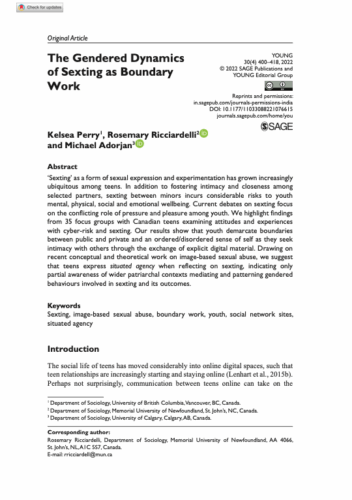Sexting
The Gendered Dynamics of Sexting as Boundary Work.
Open Access: No.
Abstract
‘Sexting’ as a form of sexual expression and experimentation has grown increasingly ubiquitous among teens. In addition to fostering intimacy and closeness among selected partners, sexting between minors incurs considerable risks to youth mental, physical, social and emotional wellbeing. Current debates on sexting focus on the conflicting role of pressure and pleasure among youth. We highlight findings from 35 focus groups with Canadian teens examining attitudes and experiences with cyber-risk and sexting. Our results show that youth demarcate boundaries between public and private and an ordered/disordered sense of self as they seek intimacy with others through the exchange of explicit digital material. Drawing on recent conceptual and theoretical work on image-based sexual abuse, we suggest that teens express situated agency when reflecting on sexting, indicating only partial awareness of wider patriarchal contexts mediating and patterning gendered behaviours involved in sexting and its outcomes.
Relevance
Young people who sext “experience physical and emotional risks to their overall wellbeing. These risks may be cumulative over time given that once an image is sent, there is no way to know for certain who may receive it… Teens who sext risk their social standing and reputation among peers” and adults, and “also risk future opportunities lest employers or university recruitment find said images, and also risk criminal sanctions if such material is discovered by parents and reported to authorities.”
“The uncertainty but hopefulness of sending private images with the intention of fostering a relationship with someone can be emotionally stimulating. These sensations, however, are braided with the riskiness of sexting—risks that we found, in line with numerous other studies, are highly gendered, with female teens experiencing the bulk of the shame and stigma that may accrue from non-consensual redistribution of sexts.” Male teens speak about sexting as “mutually beneficial” whereas female teens speak of risks to their reputation from the nonconsensual distribution of sexts by males and their male partners – norms framed by “patriarchy” and the “double standard.”
Citation
Perry, K., Ricciardelli, R., & Adorjan, M. (2022). The Gendered Dynamics of Sexting as Boundary Work. YOUNG, 30(4), 400-418. https://doi.org/10.1177/11033088221076615

